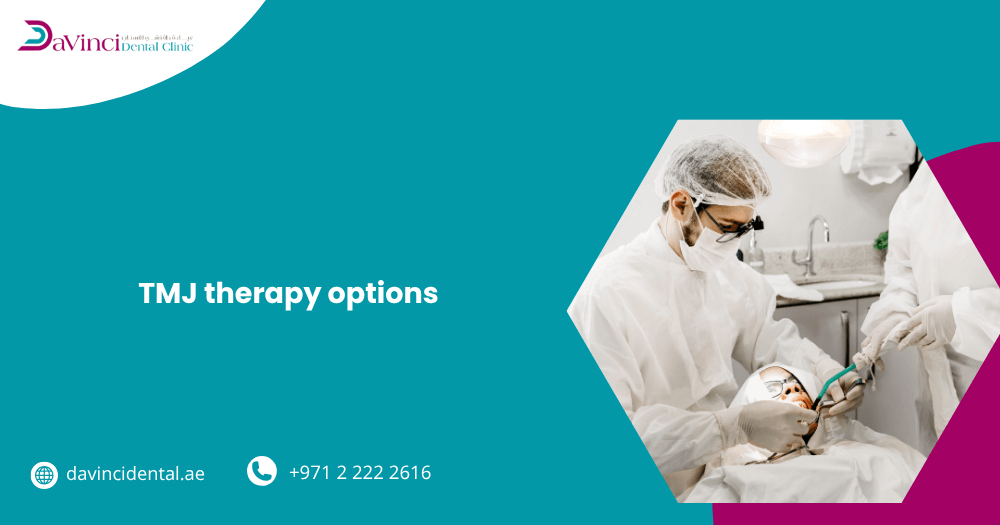A temporomandibular joint disorder (TMJ or TMD) typically exhibits signs, such as jaw discomfort, clicking noises, or stiffness, particularly when eating or speaking.
This disorder causes pain and restricted movement by affecting the joint that connects your jawbone to your skull. Fortunately, there are several TMJ therapy options available to help alleviate discomfort, improve jaw function, and prevent long-term issues.
In this post, we’ll explain how to recognize TMJ symptoms, the most effective TMJ therapy methods, and the advantages of treating TMJ issues early.
Table of Contents
How To Identify The Symptoms of TMJ?
Timely management for TMJ disorders depends on recognizing the signs early. Several signs point to a TMJ disorder, including:
- Jaw ache that never goes away, especially in the morning.
- Frequent migraines or headaches.
- Popping or clinking sounds in the jaw.
- Soreness or difficulty while opening or shutting the mouth.
- Tooth damage or heightened sensitivity.
- Back, neck, cervical, jaw joint, and facial pain.
- Posture issues (forward head position).
- Discomfort behind the eyes.
- Swelling on the lips or side of the face.
- Sideways deviation of the jaw.
- Hearing loss, ringing in the ears, and ear discomfort.
- Vertigo or dizziness.
- Visual disturbances.
- Hands and fingers tingling.
What Are The Available TMJ Therapy Options?
Many available TMJ therapy options are used to treat TMJ disorders. Your doctor will usually help you choose the best one for your specific case.
At Davinci Dental Clinic, our specialists will review your case and medical history to make a personalized treatment plan that suits your needs. Here are some of the TMJ therapy options that might be used in your treatment plan:
Self-Care Practices
Changing your diet to include more soft foods, staying away from chewing gum and other hard or chewy foods, and being aware of behaviors like jaw clenching or teeth grinding are all ways to reduce your TMJ symptoms. Additional techniques include using cold or moist heat packs, enhancing posture, lowering stress levels, and gently massaging or extending the jaw muscles.
Medications
Among the medications used to treat TMJ are:
- Painkillers such as acetaminophen and NSAIDs (ibuprofen, naproxen).
- Muscle relaxants for spasms.
- Antidepressants for persistent discomfort and teeth grinding.
- For brief durations, stronger prescription choices, such as opioids or oral corticosteroids, may be prescribed to treat severe symptoms.
Dental Appliances
By realigning the jaw, preventing teeth grinding, and lessening joint strain, dental devices like bite guards or splints can help relieve TMJ symptoms. Common varieties include nightly mouth guards that shield teeth from clenching and grinding, and hard acrylic stabilizing splints that are worn around-the-clock.
Physical Therapy
To lessen discomfort and enhance jaw function, TMJ physical therapy combines manual treatment, focused exercises, and patient education. A physical therapist can increase jaw mobility and reduce stress using a variety of techniques. Additionally, patients learn how to control their symptoms at home by using relaxation methods, posture correction, and exercises.
TENS
Low-voltage electrical currents are used in TENS (Transcutaneous Electrical Nerve Stimulation) therapy to treat TMJ discomfort. The electrical pulses help by blocking pain signals, relaxing stiff jaw muscles, releasing endorphins (the body’s natural painkillers), and increasing blood flow to the affected area. This technique, which is non-invasive and drug-free, can reduce pain and enhance jaw function.
Trigger Point Injections
A focused therapy approach created especially to address the pain and discomfort brought on by trigger points in the jaw muscles is trigger point injections. To relieve pain and promote muscular relaxation, the main objective of these injections is to “deactivate” the trigger points.
Botox
Because Botox relaxes the hyperactive jaw muscles that produce discomfort, clenching, and grinding, it can be a useful therapy for TMJ problems. It relieves symptoms, including headaches, jaw strain, and trouble opening the mouth, by momentarily preventing nerve impulses to these muscles.
Surgery
For the treatment of TMJ, surgery includes a variety of treatments, ranging from simple ones like arthroscopy (keyhole surgery with a camera) and arthrocentesis (flushing the joint) to more involved ones like open-joint surgery (arthroplasty) or total joint replacement. The goal is to restore jaw mobility, lessen discomfort, and enhance joint function.
What Are The Benefits of Treating TMJ Disorders?
Treating TMJ disorders can have many benefits, including:
- Pain Relief: Relief from frequent headaches, jaw and facial pain, and popping in the jaw.
- Better Bite: Treating TMJ disorders can give you a better bite so you can eat more easily.
- Improved Daily Functions: Enhanced capacity to speak, eat, and carry out daily tasks pain-free and without limitations.
- Better Dental Health: TMJ treatment can help reduce dental damage.
- Increased Jaw Health: Better alignment of the bite and less strain on the jaw’s muscles and joints.
- Improved Concentration: Without the pain of TMJ, you can better concentrate on your daily activities.
- Enhanced Emotional Health: Getting rid of TMJ pain and complications can improve your mental and emotional health.
Read More: How to Relieve TMJ Pain.
Conclusion
Your general quality of life, comfort, and ability to concentrate can all be negatively impacted by TMJ discomfort. Thankfully, a variety of TMJ therapy options are now available to reduce discomfort, restore jaw mobility, and stop further issues.
Every technique, from self-care routines and dental appliances to modern techniques like Botox and surgery, aims to address the underlying source of the issue and enhance normal daily activities. With the correct TMJ therapy treatment, you may restore a balanced bite, healthy joints, and long-term comfort.
Read More: TMJ Clinic.
Frequently Asked Questions
What therapy is best for TMJ?
Treatments may involve transcutaneous electrical nerve stimulation (TENS) and ultrasonography in addition to jaw muscle strengthening and stretching exercises. Additionally, stretching and heat work well when used often throughout the day.
What specialist is best for TMJ?
Historically, TMJ has been treated primarily by dentists. We now know that TMJ is a complex condition with many biological systems circulatory, digestive, endocrine, exocrine, immune, muscular, nervous, reproductive, respiratory, and skeletal playing a role. This highlights the need to include medical and other related experts in the treatment and patient care.
Can you fix TMJ without surgery?
Thankfully, several nonsurgical options are available to help lessen or eliminate your TMJ pain. These conservative techniques include physical therapy, medicine, and other alternative therapies, as well as lifestyle modifications and self-care practices.




